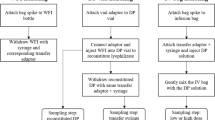Abstract
The lyophilization of proteins in microplates, to assess and optimise formulations rapidly, has been applied for the first time to a therapeutic protein and, in particular, one that requires a cell-based biological assay, in order to demonstrate the broader usefulness of the approach. Factorial design of experiment methods were combined with lyophilization in microplates to identify optimum formulations that stabilised granulocyte colony-stimulating factor during freeze drying. An initial screen rapidly identified key excipients and potential interactions, which was then followed by a central composite face designed optimisation experiment. Human serum albumin and Tween 20 had significant effects on maintaining protein stability. As previously, the optimum formulation was then freeze-dried in stoppered vials to verify that the microscale data is relevant to pilot scales. However, to validate the approach further, the selected formulation was also assessed for solid-state shelf-life through the use of accelerated stability studies. This approach allows for a high-throughput assessment of excipient options early on in product development, while also reducing costs in terms of time and quantity of materials required.



Similar content being viewed by others
References
Aucamp JP, Cosme AM, Lye GJ, Dalby PA (2005) High-throughput measurement of protein stability in microtiter plates. Biotechnol Bioeng 89:599–607
Brems DN (2002) The kinetics of G-CSF folding. Protein Sci 11:2504–2511
Carpenter JF, Pikal MJ, Chang BS, Randolph TW (1997) Rational design of stable lyophilized protein formulations: some practical advice. Pharm Res 14:969–975
Carter CR, Keeble JR, Thorpe R (2004) Human serum inactivates non-glycosylated but not glycosylated granulocyte colony-stimulating factor by a protease dependent mechanism: significance of carbohydrates on the glycosylated molecule. Biologicals 32:37–47
Chang LL, Shepherd D, Sun J, Ouellette D, Grant KL, Tang XC, Pikal MJ (2005) Mechanism of protein stabilization by sugars during freeze-drying and storage: native structure preservation, specific interaction, and/or immobilization in a glassy matrix? J Pharm Sci 94:1427–1444
Constantino HR (2004) Excipients for use in lyophilized pharmaceutical peptide, protein and other bioproducts. In: Constantino HR, Pikal MJ (eds) Lyophilization of biopharmaceuticals. AAPS Press, Arlington
Grant Y, Matejtschuk P, Dalby PA (2009) Rapid optimization of protein freeze-drying formulations using ultra scale-down and factorial design of experiment in microplates. Biotechnol Bioeng 104:957–964
Hawe A, Friess W (2006) Physico-chemical lyophilization behaviour of mannitol, human serum albumin formulations. Eur J Pharm Sci 28:224–232
Herman AC, Boone TC, Lu HS (1996) Characterization, formulation, and stability of Neupogen (Filgrastim), a recombinant human granulocyte colony-stimulating factor. Pharm Biotechnol 9:303–328
Kirkwood TB (1977) Predicting the stability of biological standards and products. Biometrics 33:736–742
Kirkwood TB, Tydeman MS (1984) Design and analysis of accelerated degradation tests for the stability of biological standards II. A flexible computer program for data analysis. J Biol Stand 12:207–214
Luthra S, Obert JP, Kalonia DS, Pikal MJ (2007) Investigation of drying stresses on proteins during lyophilization: differentiation between primary and secondary-drying stresses on lactate dehydrogenase using a humidity controlled mini freeze-dryer. J Pharm Sci 96:61–70
Narhi LO, Kenney WC, Arakawa T (1991) Conformational changes of recombinant human granulocyte colony-stimulating factor induced by pH and guanidine hydrochloride. J Protein Chem 10:359–367
Peters T (1996) All about albumin, Plenum Press, New York
Raso SW, Abel J, Barnes JM, Maloney KM, Pipes G, Treuheit MJ, King J, Brems DN (2005) Aggregation of granulocyte colony-stimulating factor in vitro involves a conformationally altered monomeric state. Protein Sci 14:2246–2257
Von Graberg S, Gieseler H (2006) Freeze drying in non-vial containers–evaluation of heat transfer coefficients of PCR plates and correlation to freeze drying cycle. In: Freeze drying of pharmaceuticals & biologicals, Garmisch Partenkirchen, Germany, Oct 3–6, 2006. http://www.freeze-drying.eu/add_doc/pub/_6.pdf. Accessed 18 Nov 2011
Wadhwa M, Thorpe R (2008) Haematopoietic growth factors and their therapeutic use. Thromb Haemost 99:863–873
Wadhwa M, Bird C, Dilger P, Mire-Sluis A, Thorpe R (2000) Quantitative biological assays for individual cytokines. In: Balkwill F (ed) Cytokine Cell Biology: a practical approach, 3rd edn. Oxford University Press, Oxford
Wadhwa M, Bird C, Hamill M, Heath AB, Matejtschuk P, Thorpe R (2011) The 2nd international standard for human granulocyte colony-stimulating factor. J Immunol Methods 367:63–69
Wang W (2000) Lyophilization and development of solid protein pharmaceuticals. Int J Pharm 203:1–60
Acknowledgments
YG gratefully acknowledges funding from the Engineering & Physical Sciences Research Council, UK and the National Institute for Biological Standards & Control. This work was done as part of the core roles of the authors.
Conflicts of interest
None.
Author information
Authors and Affiliations
Corresponding author
Electronic supplementary material
Below is the link to the electronic supplementary material.
Rights and permissions
About this article
Cite this article
Grant, Y., Matejtschuk, P., Bird, C. et al. Freeze drying formulation using microscale and design of experiment approaches: a case study using granulocyte colony-stimulating factor. Biotechnol Lett 34, 641–648 (2012). https://doi.org/10.1007/s10529-011-0822-2
Received:
Accepted:
Published:
Issue Date:
DOI: https://doi.org/10.1007/s10529-011-0822-2




